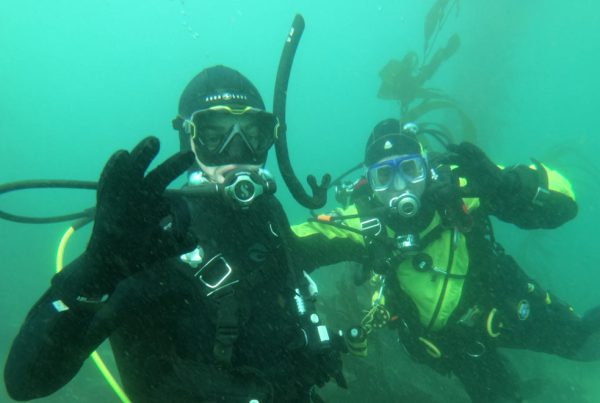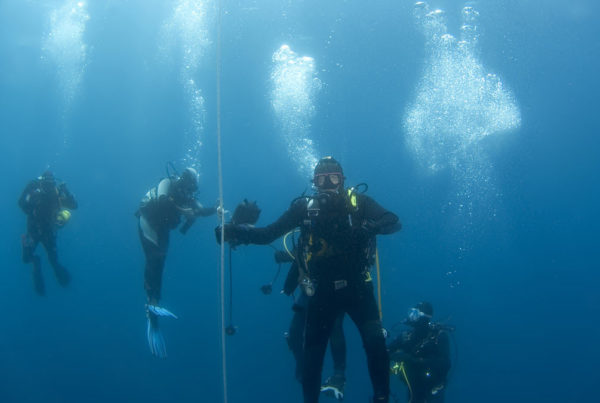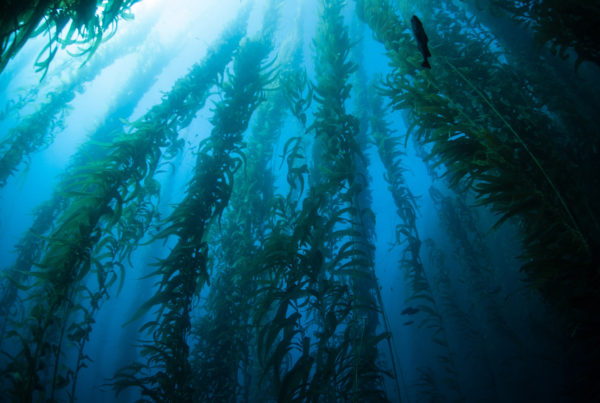Diving in a kelp forest is what makes California diving so wonderful. Kelp diving, however, requires knowledge of a few diving techniques to make it more enjoyable and safe.
First, let me start by saying that diving in kelp is not dangerous, but it does present its hazards —hazards that can be easily overcome. Entanglement is the fear of most new kelp divers—an unfounded fear. Avoiding entanglement is easy.
Equipment preparation is important. You need to streamline as much as possible, which means tucking in and fastening down loose ends, straps, and anything that can snag. Fin straps are a frequent, and often ignored, problem area. Secure with a rubber band or strip of electrical tape. Knives worn on the calf of the leg should be worn on the inside. Secure those straps as well. Better yet, put your knife in a place where it is not likely to snag but also is more accessible, like on your BC shoulder strap or arm. Attach your console, octopus and BC hose close to your body. A smooth, lead shot weight belt is less likely to snag than bricks. Remove any unused clips and gather goody bags together in such a way as to have a minimal profile.
Entering the water from a boat in or near a kelp forest is often where divers get in trouble right off the bat. Don’t rush. Wait for a clearing in the kelp. If you jump into the thick of it, you will be entangled.
Descend in a clearing. As you descend, make sure you are not dropping into a submerged kelp patch. If you are carrying a camera or speargun, keep it close to your body so that it will not snag. Once on the bottom, settle down and do a mutual buddy check for any stray kelp strands that may have been snagged on the way down.
The buddy system makes diving in kelp easier and more enjoyable. Keep and eye on each other for kelp strands that may snag here and there.
Moving through an especially thick kelp forest is not as difficult as it may seem. Stay close to the bottom among the “trunks” of the kelp stalks as this is the place of least likely entanglement, unlike the spaghetti above. Find the natural corridors through the forest and pick your way through, hands out in front if needed to part the curtain of kelp if necessary. As much as possible, stay horizontal with your head up as this will block snags on your tank valve, a common problem. If diving with a buddy, move single file through the forest while in the thickest patches. If the kelp is more loosely packed, you could possibly move side by side following parallel corridors in the kelp.
The move that most often leads to snags is turning while in the thick of the kelp. Should a snag occur, do not continue to turn as this will only aggravate the problem. Rather, once you know or sense that you are snagged, carefully reach to the point of obstruction and calmly remove the strand. Better yet, have your buddy help.
Navigation is important. You will want to return as close as possible to the boat at the kelp clearing where you descended so as to avoid an arduous trek on the surface across the kelp mat. A good idea might be to ascend to the surface half way through the dive and take a compass heading back to your return point.
Ascent is critical. Take the time to look up and find a clearing. If you must ascend under a kelp mat, use your hands to part the mat above. As with ascend, hold cameras, spearguns and other accessories close to your body.
Always allow extra air in your tank to return to your point of origin underwater and under the kelp mat should you miscalculate your navigation.
Having to “swim” over a large kelp patch on the surface is probably the worst place you could be, but even this is easily managed. The kelp mat is quite buoyant and will support you well. Do not attempt to swim through it but rather crawl over it. Push the mat down and front of you as you pass over. If you have a camera, speargun or other large accessory, hold it close to your body and push down the kelp in front of you with one hand. Do not turn over and swim on your back as this will almost guarantee a big tangle on your tank valve. It is slow going doing the kelp crawl, but take your time and rest if you get tired.
Macrocystis, the most common type of kelp divers are likely to encounter, breaks easily if you do it right (feather boa kelp can be tough). If a long macrocystis kelp strand is pulled lengthwise it will stretch and be quite resistant breaking. It does, however, break easily if you bend it an angle. It also cuts very easily. You can even easily bite through it (and it is edible!).
Kelp is our friend. Nobody should have a bad experience diving in kelp. With a few techniques, the experience of floating through California’s underwater forest should be a spiritual experience.









